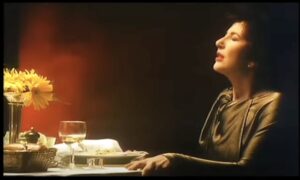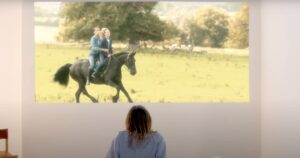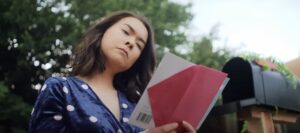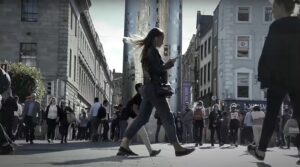Previously in these lists, we’ve featured some of our favorite songs and the streaming selections that have kept us parked in front of our televisions (and laptops) for hours on end. But for this installment of Indie Playlist we decided to combine the two and asked Indie staff and contributors to write about some of their favorite music videos — ones that make the case for considering them an art form. Who says you can’t have it all? Watch and listen along at https://tinyurl.com/IndiePlaylistSoundVision.
‘The Music Scene,’ Blockhead
Artist A.F. Schepperd’s animated music video for American producer Blockhead’s 2009 song “The Music Scene” opens with a view of a dark world from which human life has apparently disappeared. Long cords reach out to reanimate a darkened collection of television screens at the center of the frame. An eye emerges on the screen and blinks, seemingly noticing the empty armchair in front of it.

The plot continues, propelled by the machine’s hunger for spectators. Its only options are the animals picking at the remains of an empty city, who are indifferent to the machine’s attempts to entertain them. In one of the video’s most startling moments, the machine consumes the animals, using their life essence to construct a group of humanoid beings it can mold and control.
“The Music Scene” calls upon its audience to reflect on agency, consent, surveillance, and resistance. Its acerbic imagery — a not-so-subtle critique of the music industry — amplifies the repetition of the simple lyrics: “The music scene has got me down/ ’Cause I don’t want to be a clown.” Just as the machine permeated and transformed its spectators, “The Music Scene” argues that the music industry itself has done the same in constructing our ideas of what we think we want the soundtrack of our lives to be. —Aden Choate
‘The Heart Part 5,’ Kendrick Lamar
“I am. All of us.” That line, which opens the music video for Kendrick Lamar’s 2022 song “The Heart Part 5,” permeates every layer of the song and its video.

The video begins with a closed-off Lamar with his arms crossed, avoiding eye contact. He then explodes into an intense verse about the culture of violence he grew up in: “I come from a generation of pain, where murder is minor,” he raps. It’s a potent verse, if a well-trodden path for the artist.
But in the chorus, Lamar’s eyes lock onto the viewer, his posture opens, and his face morphs into O.J. Simpson’s.
He’s still rapping about his violent past, but now his words are coming out of the mouth of one of the most infamous Black men in America. Lamar continues morphing into Kanye West, Jussie Smollett, Will Smith, and other controversial Black celebrities. The viewer is never sure whether Lamar is rapping as himself or as someone else. He concludes by speaking as his friend, murdered rapper Nipsey Hussle, saying that he forgives his killer — but that “your soul is in question.”
Lamar does not attempt to excuse these men’s actions — their souls are in question, too. But he asks us to extend the same empathy to these Black celebrities that we extend to him and that he extends to his friend’s murderer. It’s an uncomfortable idea, but in “The Heart Part 5,” Lamar has no intention of making us comfortable. —William von Herff
‘This Woman’s Work,’ Kate Bush
When I think of music videos as an art form, my first choice is the 1988 video for “This Woman’s Work” by Kate Bush.

She has me from her very first coo. Her dance background is evident in her subtleties of gesture. The video’s pacing, its continuous linear flow, the range of tempo and the rising tension — all make my stomach twang. She knows how to work me up and toss me down. (And only Kate Bush can be forgiven for acting as if she’s driving a car by swinging an imaginary steering wheel back and forth. If Madonna did that, I’d rail against her. But Kate did it, and I laughed.)
Kate Bush is among the rare breed of artists who succeed in wearing all the hats: writer, director, producer. Many artists want control over every aspect of their work for egotistical reasons, but Kate needs to be at the helm because the vision is completely hers. It’s refreshing to see her single voice resonating among a cacophony of music and videos made by giant teams. Just one voice cooing out into the dark: Kate Bush understands simplicity and isn’t afraid of it. —Cody Sullivan
‘Boyhood,’ The Japanese House
Not only is this my favorite song, it’s my favorite music video, too. The Japanese House, a.k.a. musician Amber Bain, makes indie pop music that is defined by its intricate instrumental arrangements. Released in 2023, “Boyhood” is a song about trying to find yourself despite fear and past attachments.

The music video is simple. In slow motion, two people ride a black horse across a field. As the video progresses, the camera pans out to show someone sitting in bed watching the scene projected onto a wall. The person sitting in bed — the artist herself — is one of the people on the horse. At the video’s end, the projection stops, and she lies back down.
Why is she riding a horse in the video? Why are two people riding it? I have some guesses. Galloping across a field on a majestic horse is about as free as a person can get. This scene may represent Bain’s ongoing journey toward finding herself. The second person on the horse might represent past attachments that still cling to her. When we see Bain watching herself from her bed, it’s a metaphor for looking inward. Though we see only the back of her body as she looks at the screen, her body language seems positive and relaxed. Maybe she’s happy about her progress — or maybe she’s just happy to see herself happy.
But I may be completely wrong in my interpretation. That’s what I love about music videos like this one. Just like the song it illustrates, the video means what I want it to mean. —Eve Samaha
‘Nobody,’ Mitski
This year I made the transition from living in a co-op with 25 roommates to living in a cottage all by myself. There are moments I’ve loved this: reading for hours uninterrupted, leaving the dishes for tomorrow, blasting Britney at 8 a.m. There are other moments where I’ve felt I’m teetering on solipsism, an anguish that is depicted with wry delight in the music video for Mitski’s 2018 single “Nobody.”

Mitski wakes from a nightmare in which she is on a date with herself at a diner sipping from an hourglass with a straw. “My God, I’m so lonely,” the song begins, “So I open the window/ To hear sounds of people.” The walls of her apartment are a mocking sunshine yellow covered with blank Post-it notes, each one a reminder of nothing at all.
She receives a package and opens it to find a painting of a woman with a blank slate for a face. When she hangs it, arms pop out of the wall and begin to claw at the canvas, turning the blank slate into a gash. “And I don’t want your pity,” Mitski sings, “I just want somebody near me.”
At the end of the video, Mitski drags a human-sized diary out from under her bed and opens it to find a smaller diary inside. This keeps going, like matryoshka dolls for selfhood. When she finally reaches the smallest one, she needs a magnifying glass to make out what she has written. It’s the same word written over and over again: “Nobody, nobody, nobody.”
If you live alone, I recommend that you take advantage of that fact and belt this one in the shower — hairbrush in hand, just the way Mitski does. —Paul Sullivan
‘Someday,’ Weval
In 1894, a music publishing company in New York City began promoting popular songs of the day with public projections of magic lantern slides accompanied by a live musical performance: the precursor of the modern music video. For all its technical sophistication, Irish artist Páraic Mc Gloughlin’s 2019 video for the Dutch electronic duo Weval’s “Someday” returns the art of the music video back to those early origins. Using a technique called kinestasis, a type of computer-manipulated stop-motion photography, Mc Gloughlin uses thousands of still images to create a seamless and hypnotic blend of motion, sound, and narrative.

Over a tangle of polyrhythms, the images ascend from abstracted staircases, escalators, and manhole covers through crowded cityscapes to the spires and domes of cathedrals and mosques and higher into the skies above a densely populated Earth — before returning to the primordial forest where it all began. The song’s lyrics don’t extend much beyond its title: the word “someday” becomes a sort of mantra, an expression of hope for the future suffused with a melancholy for the fact that the present moment is passing us faster than we can comprehend it.
Aside from its virtuoso editing, the video is a powerful meditation on human experience and mortality in just over four minutes: an economy of expression that few other media besides music videos can accomplish in so short a time. —John D’Addario



